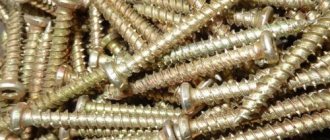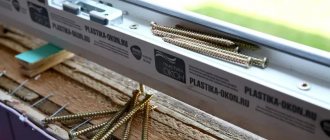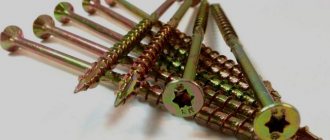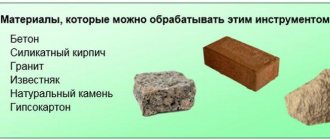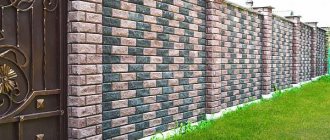Driving a screw into a concrete wall is not an easy task. Every man had to do this at some point. After all, everyone has gone through renovations in their homes. Installing a screw will not cause any difficulties if you know the fastening technology in advance and have an idea of the types and features of this fastening material.
This article will tell you about concrete screws without drilling and with it, about their installation and cost.
Features of the selection and use of concrete screws
A concrete screw has a second name: dowel. In appearance, it is an elongated cylindrical object with a head, threads and a sharp tip. The screw has a Phillips or hex head. Pins are made from an alloy of iron and carbon. Thanks to the material, hardware has good strength, protection from corrosion and other external influences.
Concrete screws are available in three colors. Depending on the color, they can be used in different conditions.
When buying screws in a store, first of all take into account the expected load. That is, you need to immediately assess how much weight the screw will hold. Screws designed to hold light weight should not be used for bulky or heavy objects.
Concrete screws can also be used when working with brick. Pins are good at fastening wooden structures to a concrete base. These hardware are often used for fastening aluminum profiles, PVC windows and wooden windows.
Concrete screw MMS-S (photo)
Their varieties
Knowing the types and their features, you can make the right choice of fasteners. There are several types of hardware products for concrete. The classification has three groups and several subgroups:
- By thread pitch and shape.
- According to the head configuration.
- By type of coverage.
The video below will explain in an accessible form how to install a dowel screw on concrete:
By thread pitch and shape
Depending on the thread pitch and shape, concrete screws are:
- Universal screws with a diameter of 3-6 mm and a length of 12-220 mm. The main feature of such hardware is that they can be immediately mounted into a concrete wall or screwed into a mounting hole. Such hardware is famous for its versatility.
- Universal screws with herringbone thread . The length of such screws is 12-220 mm, diameter 3-8 mm. The use of such a screw for concrete is only possible in conjunction with a dowel. Often the dowel comes complete with a dowel. If there are voids in the concrete wall, it is recommended to use an impact dowel during installation. The length of the screw and dowel are the same. The depth of the hole for the hardware must be 3-5 mm greater than the length of the screw itself.
- Variable thread dowel screws . These products do not require pre-drilling. Thanks to the serrated threads, this screw fits easily into the wall. This type is available with the same diameter (7.5 mm), but with different lengths (70-200 mm).
According to head configuration
According to the head configuration, screws are:
- Hardware with a countersunk or conical head. These screws have a Phillips recess.
- Hex head hardware . These concrete screws are designed for Phillips open-end wrenches with internal threads.
- Hardware-studs . These screws have a threaded stack for the nut.
- Hardware - hooks . These screws have a rectangular head.
The last two types must be installed only in a pre-prepared, drilled and sealed hole. Other shooting ranges can be used with or without pre-drilling.
By type of coverage
- First type: black hardware . These are carbon steel hardware with an oxidized coating. Designed for use in indoor areas with normal humidity.
- Second type: silver hardware . They are coated on top with a protective layer of zinc. Used for external and internal work. They are famous for their ubiquity. Can be used in any, even very harsh conditions.
- Third type: yellow hardware . This type can only be used indoors and only on concrete.
Read below about the size and weight of concrete screws according to GOST.
Purpose and classification of dowel
The purpose of the dowel is to ensure reliable fastening of various structures to solid foundations. The adhesion strength is due to the notches, which is why the fasteners hold well in substrates of different compositions. The deeper the dowel is fixed, and the longer its length, the higher its load-bearing capacity. Therefore, the tool is most often used when installing doors, windows, hanging furniture, chandeliers, and radiators.
Concrete dowels can be classified according to:
- type of protective layer (color);
- head type;
- threading.
The color of the dowel is a type of protective layer. The following types exist:
- blackened (oxidized), which is suitable for interior work in rooms with normal humidity levels;
- brass is used only for interior work;
- galvanized (zinc treatment is used) - universal, can be used anywhere, it is resistant to kinks, scratches and rust.
Shape of the screw head (dowel) for concrete - TORX
Based on the shape of the head, the following can be distinguished:
- stud with threaded fitting for fastening the nut;
- countersunk head in the form of a cone with cross-shaped slots;
- hexagon: to tighten it, you will need a box or open-end wrench;
- the head of a rectangle (croc) in the form of a loop-shaped anchor. Used for chandeliers, cornices, hanging swings, cabinets;
- type of torx head - specific dowels for an imbus wrench.
Type of thread of the screw (dowel) for concrete - screw
Thread form:
- herringbone thread - universal fastener, used in conjunction with a dowel pair: you need to drill a hole for the dowel, and then, using a screwdriver, screw the hardware into it;
- screw thread. Hardware with this type of thread is universal and is used to perform a wide range of tasks: it can be used either independently or in combination with a dowel;
- replaceable threading facilitates adhesion, ensuring a tight connection and does not allow the fastener to become loose. The hardware is used independently; it is necessary to pre-drill the hole.
Product parameters
The size of the screw is directly proportional to the load.
- For example, if a cabinet weighing five kilograms is attached to the wall, then a screw with a diameter of 3 mm and a length of 2.5 cm can handle this load.
- If you have to fasten a hundred-kilogram object, you will have to use a self-tapping screw with a diameter of 10 mm and a length of more than 16 cm.
Depending on the type, screws come in the following sizes.
Yellow
Yellow screw:
- Diameter: 2.5mm, 3.0mm, 3.5mm.
- Length: 10mm, 12mm, 13mm, 16mm, 20mm, 25mm, 30mm, 40mm, 45mm.
- Weight of 1 piece: from 0.3 g. up to 1.9 gr.
For example, one screw measuring 3.0x12 mm weighs 0.4 g. A thousand pieces of this size will weigh 0.4 kg. One kilogram contains approximately 2,500 hardware.
White
White screw:
- Diameter: 2.5mm, 3.0mm, 3.5mm.
- Length: 10mm, 12mm, 13mm, 16mm, 20mm, 25mm, 30mm, 40mm, 45mm.
- Weight of 1 piece: from 0.3 g. up to 1.6 g.
For example, one white screw measuring 2.5x10 mm weighs 0.3 g. A thousand pieces of this size would weigh 0.26 kg. There are approximately 3846 pieces in one kilogram.
Black
Black screw:
- Diameter one: 7.5 mm.
- Length: 52mm, 72mm, 92mm, 112mm, 132mm, 152mm, 182mm, 202mm.
- Weight of 1 piece: from 10 g. up to 36.2 gr.
For example, one screw measuring 75x202 mm weighs 36.2 grams. A thousand pieces of this size would weigh 36.2 kg. One kilogram contains approximately 28 pieces of hardware.
Concrete screws are manufactured in accordance with GOST 1146-80.
Next, we will tell you which hole to drill and how to use dowels and tighten screws on concrete.
Concrete screw FBS-M8/M10
Concrete screw size chart
Classification of brass dowel (screw) sizes by length
Table 1 - Dowel dimensions and areas of application
| Protective layer | Weight | Length | Diameter | Where are they used? |
| Blackened oxidized | 10-36.2 g | 52-202 mm | 7.5 mm | Universal hardware, made of carbon steel with oxidized coating. Used for interior work in rooms with relatively low humidity. Cannot be used outdoors, in the basement, on the balcony. |
| Silver galvanized | 0.3-1.6 g | 10-45 mm | 2.5 mm; 3 mm; 3.5 mm | Universal multifunctional hardware made of corrosion steel with zinc coating. Used in outdoor and indoor areas. Insensitive to humidity and various deformations. |
| Brass | 0.3-1.9 g | 10-45 mm | 2.5 mm; 3 mm; 3.5 mm | Hardware made of copper and zinc alloy is intended for interior use only. Used for aerated concrete, decorative elements and in places where fasteners are visible. |
Installation
Calculation of hardware
To determine the number of screws needed:
- Know the scope of work to be performed and the dimensions of the part to be fixed.
- Know the distance between future fastenings.
In practice, the specified distance is used equal to 70-100 mm. So, for a painting measuring 60 mm by 90 mm, you will need 4 screws (they will need to be installed in 4 corners). If a cabinet measuring 130 mm by 150 mm is attached to the wall, then these are 8 screws. Of course, these are rough estimates.
Technology
Tools
If there is a dowel and a prepared hole, then the screw can bear quite a lot of weight. If, on the contrary, the load is small, then you can fix the object on the wall without a dowel. That is, there are two methods of fastening.
Fastening to concrete will require the following tools from the master:
- Screwdriver.
- Drill.
- Hammer.
- The concrete screws themselves.
First of all, markings are made. To do this, you need to decide where and in what quantity screw holes are needed. It all depends on the type of material being fixed and the nature of the work.
The process of using concrete screws is presented in this video:
Important Tips
When installing, be sure to use the following tips:
- It is necessary to retreat 5 or 6 cm from the edge of the material.
- A maximum distance of 60 cm is permissible only when installing PVC windows.
- If wooden or aluminum windows are fastened, the distance between the screws should be 70 cm.
- In all other cases, the distance between concrete hardware should not exceed 60 cm.
- The concrete surface must be drilled 4.5 cm deep, and the hardware must be 3 cm long.
- Lightweight concrete is drilled at a distance of 7.5 cm, and hardware is fastened together at a distance of 6 cm.
- It is advisable to drill a pumice surface to a depth of 6.5 cm and maintain a distance between hardware of 5 cm.
- The sand-lime brick surface is drilled to a depth of 5.5 cm, and the screw is driven to a depth of 4 cm.
- A solid brick is drilled to a depth of 5.5 cm. A distance of 4 cm is left between the hardware.
Anchor screws (anchors) for concrete

